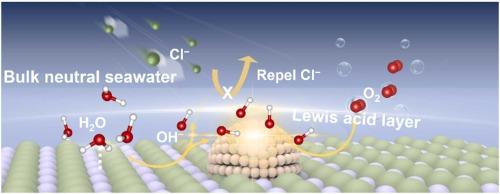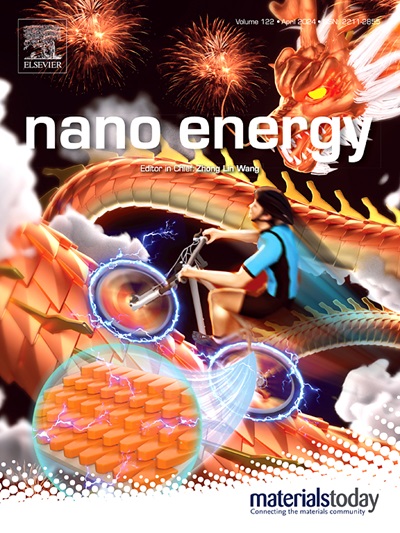Hard Lewis acid induced chloride repulsion for durable neutral seawater electrolysis
IF 17.1
1区 材料科学
Q1 CHEMISTRY, PHYSICAL
引用次数: 0
Abstract
The development of efficient and stable catalysts for the neutral seawater oxygen evolution reaction (OER) is essential for sustainable hydrogen production; however, the competitive chlorine evolution reaction (CER) poses a critical challenge. Herein, nanosheet-like RuO₂@Nb₂O₅ catalysts are constructed and applied to repel Cl⁻ in seawater based on the Lewis acid-base theory. Experiments combined with density functional calculations reveal that Nb₂O₅ as a hard Lewis acid is able to promote the decomposition of H₂O molecules, and the in-situ generated OH⁻ layer significantly reduces Cl⁻ interaction. Notably, Nb₂O₅ also modulates the electronic structure of RuO₂, weakening Cl⁻ adsorption and shifting the OER pathway from the lattice oxygen mechanism to the more stable adsorbate evolution mechanism. After electrolysis for the same duration, the concentration of ClO⁻ in the electrolyte of RuO₂@Nb₂O₅ is approximately one magnitude lower than that of commercial RuO₂. The obtained RuO₂@Nb₂O₅ shows impressive OER activity in neutral seawater (pH ≈ 7.8) and displays considerable durability for up to 100 h.

硬路易斯酸诱导氯排斥持久中性海水电解
开发高效稳定的海水中性析氧反应催化剂是实现海水中性析氧反应可持续制氢的关键;然而,竞争性氯析出反应(CER)提出了严峻的挑战。在此,基于刘易斯酸碱理论,构建了纳米片状的RuO₂@Nb₂O₅催化剂,并将其应用于击退海水中的Cl⁻。实验结合密度泛函计算表明,Nb₂O₅作为一种硬路易斯酸,能够促进H₂O分子的分解,并且原位生成的OH -⁻层显著降低了Cl -⁻的相互作用。值得注意的是,Nb₂O₅也调节了RuO₂的电子结构,削弱了Cl -⁻吸附,并将OER途径从晶格氧机制转变为更稳定的吸附物演化机制。经过相同时间的电解后,ClO⁻在RuO₂@Nb₂O₅的电解质中的浓度比商业RuO₂的浓度低大约一个数量级。所得的RuO₂@Nb₂O₅在中性海水(pH≈7.8)中显示出令人印象深刻的OER活性,并显示出长达100小时的相当耐久性。
本文章由计算机程序翻译,如有差异,请以英文原文为准。
求助全文
约1分钟内获得全文
求助全文
来源期刊

Nano Energy
CHEMISTRY, PHYSICAL-NANOSCIENCE & NANOTECHNOLOGY
CiteScore
30.30
自引率
7.40%
发文量
1207
审稿时长
23 days
期刊介绍:
Nano Energy is a multidisciplinary, rapid-publication forum of original peer-reviewed contributions on the science and engineering of nanomaterials and nanodevices used in all forms of energy harvesting, conversion, storage, utilization and policy. Through its mixture of articles, reviews, communications, research news, and information on key developments, Nano Energy provides a comprehensive coverage of this exciting and dynamic field which joins nanoscience and nanotechnology with energy science. The journal is relevant to all those who are interested in nanomaterials solutions to the energy problem.
Nano Energy publishes original experimental and theoretical research on all aspects of energy-related research which utilizes nanomaterials and nanotechnology. Manuscripts of four types are considered: review articles which inform readers of the latest research and advances in energy science; rapid communications which feature exciting research breakthroughs in the field; full-length articles which report comprehensive research developments; and news and opinions which comment on topical issues or express views on the developments in related fields.
 求助内容:
求助内容: 应助结果提醒方式:
应助结果提醒方式:


